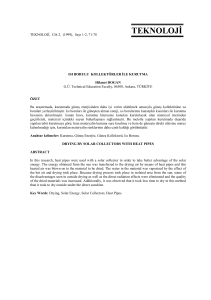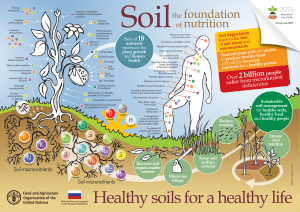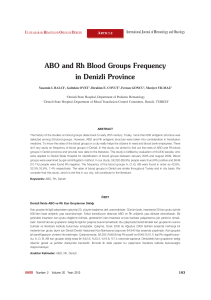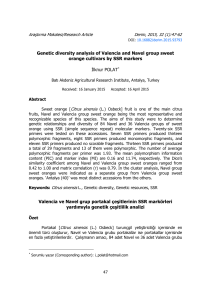Uploaded by
common.user16672
Malatya: World's Apricot Capital - Apricot Culture
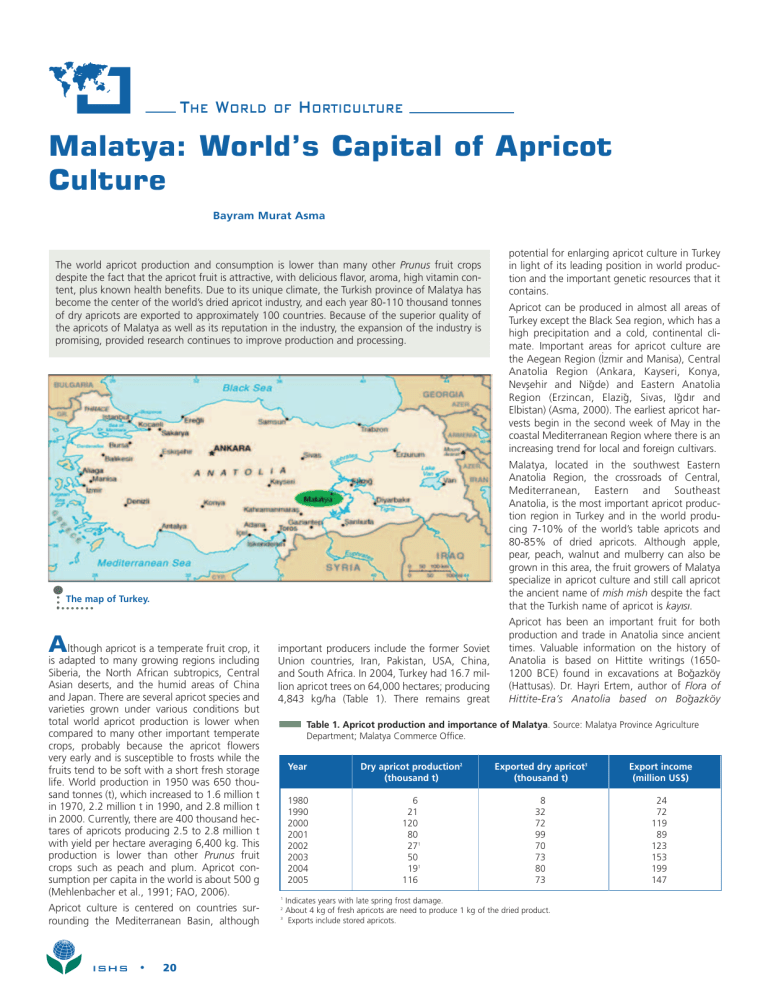
THE WORLD OF HORTICULTURE Malatya: World’s Capital of Apricot Culture Bayram Murat Asma The world apricot production and consumption is lower than many other Prunus fruit crops despite the fact that the apricot fruit is attractive, with delicious flavor, aroma, high vitamin content, plus known health benefits. Due to its unique climate, the Turkish province of Malatya has become the center of the world’s dried apricot industry, and each year 80-110 thousand tonnes of dry apricots are exported to approximately 100 countries. Because of the superior quality of the apricots of Malatya as well as its reputation in the industry, the expansion of the industry is promising, provided research continues to improve production and processing. Apricot can be produced in almost all areas of Turkey except the Black Sea region, which has a high precipitation and a cold, continental climate. Important areas for apricot culture are the Aegean Region (İzmir and Manisa), Central Anatolia Region (Ankara, Kayseri, Konya, Nevşehir and Niǧde) and Eastern Anatolia Region (Erzincan, Elaziǧ, Sivas, IǧdIr and Elbistan) (Asma, 2000). The earliest apricot harvests begin in the second week of May in the coastal Mediterranean Region where there is an increasing trend for local and foreign cultivars. Malatya, located in the southwest Eastern Anatolia Region, the crossroads of Central, Mediterranean, Eastern and Southeast Anatolia, is the most important apricot production region in Turkey and in the world producing 7-10% of the world’s table apricots and 80-85% of dried apricots. Although apple, pear, peach, walnut and mulberry can also be grown in this area, the fruit growers of Malatya specialize in apricot culture and still call apricot the ancient name of mish mish despite the fact that the Turkish name of apricot is kayIsI. The map of Turkey. Although apricot is a temperate fruit crop, it is adapted to many growing regions including Siberia, the North African subtropics, Central Asian deserts, and the humid areas of China and Japan. There are several apricot species and varieties grown under various conditions but total world apricot production is lower when compared to many other important temperate crops, probably because the apricot flowers very early and is susceptible to frosts while the fruits tend to be soft with a short fresh storage life. World production in 1950 was 650 thousand tonnes (t), which increased to 1.6 million t in 1970, 2.2 million t in 1990, and 2.8 million t in 2000. Currently, there are 400 thousand hectares of apricots producing 2.5 to 2.8 million t with yield per hectare averaging 6,400 kg. This production is lower than other Prunus fruit crops such as peach and plum. Apricot consumption per capita in the world is about 500 g (Mehlenbacher et al., 1991; FAO, 2006). Apricot culture is centered on countries surrounding the Mediterranean Basin, although ISHS • potential for enlarging apricot culture in Turkey in light of its leading position in world production and the important genetic resources that it contains. 20 important producers include the former Soviet Union countries, Iran, Pakistan, USA, China, and South Africa. In 2004, Turkey had 16.7 million apricot trees on 64,000 hectares; producing 4,843 kg/ha (Table 1). There remains great Apricot has been an important fruit for both production and trade in Anatolia since ancient times. Valuable information on the history of Anatolia is based on Hittite writings (16501200 BCE) found in excavations at Boǧazköy (Hattusas). Dr. Hayri Ertem, author of Flora of Hittite-Era’s Anatolia based on Boǧazköy Table 1. Apricot production and importance of Malatya. Source: Malatya Province Agriculture Department; Malatya Commerce Office. 1 2 3 Year Dry apricot production2 (thousand t) Exported dry apricot3 (thousand t) Export income (million US$) 1980 1990 2000 2001 2002 2003 2004 2005 6 21 120 80 271 50 191 116 8 32 72 99 70 73 80 73 24 72 119 89 123 153 199 147 Indicates years with late spring frost damage. About 4 kg of fresh apricots are need to produce 1 kg of the dried product. Exports include stored apricots. Apricot flowering and fruiting: orchard in bloom (left), closeup of flowers (middle), and immature fruit, about 30-35 days old (right). A B C D E F Apricot cultivars: (A) ‘HacIhaliloǧlu’, (B) ‘Kabaaşi’, (C) ‘Alyanak’, (D) ‘Çöloǧlu’, (E) ‘SoǧancI’ and (F) ‘Aǧerik’. Manuscripts (1974), suggests that tree fruit production played an important role in the economy of the Hittite Era, 18th to 8th century BCE, along with viticulture, field crops, and animal culture. A tablet from that era, Kbo V 7 Rs.28, contains the information that a person named Tiuatapara had 42 apricot trees. Tablet VI 12 Vs. I 17-21 refers to a law that prohibits damaging vines, figs, apples, and apricots. Hittites called apricot hashur.kur.ra, which derives from Sulphur rooms at Malatya. Sumerian where hashur means “mountain” and kur.ra means “apple” (Ertem, 1974). Hittites used apricot for both fresh and dry consumption and apricot found a place in religious ceremonies. These findings indicate that there has been apricot culture in Anatolia before the Asian journey of Alexander the Great who crossed Anatolia in the 4th century BCE. APRICOT CULTURE IN MALATYA Apricot is grown in almost all orchards in Malatya. The region has 8 million apricot trees, 73% of which consists of ‘HacIhaliloǧlu’, a cultivar perfectly suitable for drying, followed by ‘KabaasI’ (17%); other cultivars include ‘Hasanbey’, ‘Çataloǧlu’, ‘Soǧanci’, ‘Çöloǧlu’, ‘Alyanak’, ‘Şekerpare’, ‘Kurukabuk’ and ‘Ismailaga’. Breeding efforts in the Apricot Research Center of Inonu University in Malatya have produced selections now under test such as ‘Levent’, an extremely late apricot (Asma and Birhanli, 2004). ‘HacIhaliloǧlu’, the most important drying apricot cultivar of Malatya, was selected in 1850. The trees are vigorous, and produce fruits every year in irrigated and well-managed orchards. It is medium-yielding but susceptible to frosts, drought, and some diseases such as brown rot (Sclerotinia laxa) and shothole (Coryneum beyerinckii). The fruits are medium-sized, 25-35 g, oval-shaped, symmetrical; skin and flesh colors are yellow. Fruit has a tendency to be red blushed. Flesh is firm-textured, low in water content, very sweet, and aromatic. On average the fruit has 24-28% soluble solids, 0.200.40% acidity and pH is 4.5-4.8. The pit (1.72.2 g) is oval and does not cling to the flesh; kernel is sweet. Fruits are mature in the second week of July in Malatya. The chilling requirement is 850-100 hours (Anon., 1996; Gülcan et al., 2001; Asma, 2000). ‘Hasanbey’ is a table cultivar developed in 1930 by Hasan Derinkˆk, first mayor of Malatya City. The tree shape is spreading and vigorous. It is medium yielding and has heart-shaped fruit (40-55 g). Fruit skin and flesh colors are yellow; texture is medium. On average it has 18-22% soluble solids, 0.10-0.20% acidity and 4.9-5.1 pH. The pits are long-oval, 2.0-2.8 g, non-cling; kernels are sweet. In Malatya, harvest occurs at CHRONICA HORTICULTURAE • VOL 47 • NUMBER 1 • 2007 • 21 end of June (Gülcan et al., 2001; Asma and BirhanlI, 2004). ‘Şekerpare’ was selected in Malatya in 1941 and can be used as a table and drying cultivar. The tree shape is globular with vigorous growth; it is high-yielding. Fruit size is 25-30 g, oval-shaped, with yellow fruit. Yellow skin is russeted and spotted. The oval-shaped pits (1.8-2.3 g) are non-cling; kernels are sweet. Soluble solids are 20-25%, acidity is 0.200.30%, and pH is 4.1-5.2. Generally, harvest occurs in the first week of July in Malatya (Asma and Birhanli, 2004). ‘Aǧerik’ is a table cultivar selected in Kars in 1977. Tree shape is globular and growth is vigorous but yield is medium. Fuits are 60-75 g, oval-shaped; fruit skin and flesh are white. The fruits are only moderately sweet, firm-textured, and have 15-17% soluble solids, 0.8-0.95 acidity and pH is 3.7-3.9. Harvest date in Malatya is the middle of July. Apricot fruits drying in the sun. the end of June and beginning of July (Asma and Birhanli, 2004). ‘Kabaaşi’ is a drying apricot selected in 1960. The trees are medium-sized and grow straight and vigorously; yield is medium. Yellow fruit is medium-sized (30-35 g) and oval-shaped. The fruits are sweet, and on average have 24-26% soluble solids, 0.30-0.45% acidity, and 3.8-4.6 pH. The pit shape is oval, 1.9-2.4 g, non-cling to flesh; kernels are sweet. In Malatya, harvest occurs in the second week of July (Özçaǧiran et al., 2004). ‘Soǧanci’ is a table and drying apricot cultivar obtained from studies by Ruhi KadIoglu’s in 1973. The trees are large, upright to globeshaped, and vigorous. The fruits are 30-40 g, oval-shaped and both fruit and skin colors are yellow. The fruit is sweet and firm-textured. The soluble solids of fruits are 23-26%, acidity is 0.28-0.35%, and pH is 4.5-4.7. The pits are round in shape, 1.8-2.2 g, non-cling; kernels are sweet. The maturation period is the second week of July in Malatya (Asma, 2000). ‘Çataloǧlu’ is a drying, high yielding cultivar, morphologically similar to ‘HacIhaliloǧlu’ but with better color (Özçaǧiran et al., 2004; Asma, 2000). Tree shape is spreading and vigorous. The fruits are medium, 25-35 g, oval-shaped with yellow skin and symmetrical. Yellow flesh is firm-textured, sweet, and aromatic with low water content. On average, the soluble solids are 24-28%, acidity is 0.10-0.25% and pH is 4.5-4.9. The pits are oval-shaped, 1.7-2.1 g, sweet and non-cling. ‘Çöloǧlu’ can be both a table and drying cultivar with exceptional taste and aroma. Trees are medium-sized and vigorous, tolerant to drought but susceptible to brown rot (Sclerotinia laxa) and shothole (Coryneum beyerinckii). The fruit is round, 25-35 g, with an apparent carpel line, ISHS • 22 with two asymmetric halves. Skin and flesh color is yellow. The fruits are very sweet and soft-textured. On average, the pH is 4.7-5.1; soluble solids are 22-25%. The pit shape is round (1.9-2.3 g) and non-cling; kernels are sweet. Harvest begins on the second week of July in Malatya (Gülcan et al., 2001; Özçaǧiran et al., 2004; Asma, 2000). ‘Alyanak’ is an early, high-yielding, table cultivar selected in Malatya in 1961. The tree shape is round and growth is vigorous. Fruits are 30-45 g, oval-shaped. Fruit skin is orange with red blush, and flesh is orange. Fruits are only moderately sweet, soft-textured and on average have 12-14% soluble solids, 0.9-1.1% acidity, and 3.5-3.9 pH. In Malatya, the harvest date is the ‘Levent’ was found in 1993 in Malatya and is extremely late and high yielding. The fruit development period is 180-193 days. Tree shape is spreading and growth is vigorous. Fruits are small, 22-25 g and round, with yellow skin and flesh. The fruit is sweet and the texture is medium. The pits are sweet and 1.8-2.1 g and not clinging to the flesh. Fruit has 1718.5% soluble solids, 0.95-1.15% acidity, and 3.6-3.8 pH. Fruits are harvested at the end of September in Malatya (Asma and Öztürk, 2005). Apricot Harvest and Drying In Malatya, apricot is harvested in July. The soil is covered with plastic covers and the trees are vibrated so the fruits drop onto the covers. Fruits are gathered into containers and carried to the drying area. Dried apricots ready for shipment to processing factory. Sulfured and non-sulfured dried apricot: high, medium, low and no sulphur (left to right). Apricot fruit profoundly changes its color during the drying process. Fruits are dried either without any treatments or after sulfur dioxide treatments. The sulfuring process not only keeps the color of apricot during drying but also avoids pest damage during storage. The fresh fruits are placed in wooden containers (90 x 180 cm); and the containers are kept in the sulfuring room for 8 to 12 hours. The ideal sulfuring rooms (2.5 x 2.5 x 2.2 m height) have walls of 30 cm thick, which are either brick or reinforced concrete. The airproof door of the sulfuring room is 110 cm in width and 200 cm in height. It is possible to treat 1,200-1,500 kg fresh apricots at once in each room. In the elemental sulfur method, sulfur is heated to form sulfur dioxide. For each 1,000 kg of fresh fruit 2-3 kg of sulfur is applied. Alternatives include liquid forms of sulfur such as sodium metabisulfite, sodium sulfite, or pure sulfur gas. There is no need for heating when sodium metabisulfite or sodium sulfite is used, since they are well dissolved in aqueous solutions. When sulfur gas is used, pre-heating of sulfuring room helps fruits to take up sulfur dioxide better. In Malatya apri- Apricot processing. cot growers, however, prefer the elemental sulfur method. After the sulfuring, the fruits are placed in containers under direct sunlight and pits are removed by hand by squeezing each fruit. During the sun-drying process, water content drops to 20-25% (Asma, 2000). Sulfuring is an integral part of the dried apricot industry. There are no known harmful effects of the sulfuring process on human health except for asthmatics. However, European Union Regulation restricts the amount of sulfur in dry apricot to 2000 ppm; the limit is 2500 ppm in A tray with sulfured and non-sulfured dried apricots. Canada and 3000 ppm in the US. Sulfur treatment keeps apricots yellow and is necessary to preserve the dried product for an extended period of time. Natural Drying (Gün Kurusu) Fruits can be dried without sulfur treatment but the resulting product is brown, not yellow or orange, and the taste is different. The harvested fruits are carried to the drying areas, places on reinforced concrete or cover in a single layer. After the initial drying for a few days, the fruits are pitted, shaped and returned to the drying area until their water content drops to 10-13%. Since there are no sulfur treatments in natural drying, fruits brown because of enzyme activity. The naturally dried fruits must be kept refrigerated because they can deteriorate quickly under room temperature. The Processing Industry The market for the dry apricot in Malatya is called “Şire PazarI” (meaning sweet bazaar). Buyers purchase apricots from producers and bring them to apricot processing facilities. In Malatya, there are 25 processing facilities. Here, the dry apricots are first washed several times and then dried in special ovens until their water content drops to 25%. The apricots are sized, sorted, and defects excised by paring. The product is packed into 0.5, 1, 5 and 12.5 kg trays by workers, usually young Turkish women. The dried fruit is then distributed to local and global markets! There are other facilities in Malatya that prepare different apricot products such as jam and marmalades from either dry or fresh apricots, juice, CHRONICA HORTICULTURAE • VOL 47 • NUMBER 1 • 2007 • 23 than 5,000 hybrids from more than 50 combinations are being evaluated in the field for several objectives including early and late ripening, high drying efficiency, and resistance to Sharka (Plum pox virus). MAJOR PROBLEMS OF MALATYA’S APRICOT CULTURE Apricot products displayed by Ipek, daughter of the author. sweets, and pekmez, a local, thick, leathery apricot product made by boiling down the juice. Apricot marmalade is important for preparation of jams and cakes. For example, “Sachertorte,” prepared for several centuries, requires apricot marmalade. The seeds of apricots are also widely used. Amaretti Di Saronno is prepared from apricot seeds in Italy. Each year, Malatya exports about 10 thousand tonnes of apricot seeds valued at $10-12 million. Apricot Breeding The Apricot Research Center of Inonu University has several apricot breeding programs. More There are a number of serious problems that need to be resolved for the apricot industry of Malatya to expand. Price fluctuations of dry apricot in the markets cause hardship to the industry. For example, late spring frosts occur every 2 to 3 years and cause significant yield losses. In the nonfrost years, overproduction often depresses market prices. New cultivars that can tolerate the spring frosts better than the current ones should be utilized in new orchards. The consumption preferences and market conditions are dynamic. With the exception of studies at the Apricot Research Center of Inonu University, there have been few attempts to breed for cultivars to increase the production area for dried apricots. At present, certified nursery trees are insufficient. Attempts need to be made to increase certified nursery tree production. Management practices such as irrigation, fertilization, pest management, need to be upgraded. Extension efforts need to be expanded in the industry. Attempts need to be made to increase apricot consumption. There have been few researches emphasizing the health benefits of dried apricot consumption. Scientific research and a marketing program to emphasize health benefits are needed to increase apricot consumption. Attempts should be made to develop valueadded products from apricots in Turkey. These include frozen or canned apricot products and apricot marmalade. Finally research needs to be done on increasing organic production. ACKNOWLEDGEMENTS I thank Jules Janick and Sedat Serçe for assistance with this manuscript. REFERENCES Anon. 1996. Catalog of apricot varieties. Turkish Agriculture Ministry Press, Ankara. Asma, B.M. 2000. Apricot production (in Turkish). Evin Press, Malatya. Asma, B.M. and BirhanlI, O. 2004. Mişmiş (in Turkish). Evin Press, Malatya. Asma, B.M. and Öztürk, K. 2005. Analysis of morphological, pomological and yield characteristics of some apricot germplasm in Turkey. Genet. Resour. Crop Evol. 52:305-313. Ertem, H. 1974. Flora of Hittite-Era’s Anatolia based on Boǧazköy Manuscripts (in Turkish). TTK Press, Ankara. FAO. 2006. FAO statistical database. http://apps.fao.org/page/collections?subset=a griculturegg Gülcan, R., MIsIrlI, A., Eryüce, N., Saǧlam, H. and Demir, T. 2001. Apricot production (in Turkish). TARP Press, Ankara. Mehlenbacher, S.A., Cociu, V. and Hough, L.F. 1991. Apricots (Prunus). Acta Hort. 290:65107. Özçaǧiran, R., Ünal, A., Özeker, E. and İsfendiyaroǧlu, M. 2004. Temperature fruits. (Stone fruits). Vol.II, Egean Univ. Agr. Faculty Press, 553, İzmir. Market displaying the various dried fruits of Turkey. ABOUT THE AUTHOR Bayram Murat Asma Dr. Bayram Murat Asma is the Director of the Apricot Research Centre, Inonu University, Malatya, Turkey. He has been studying apricot breeding since 1990. Email: [email protected] ISHS • 24
